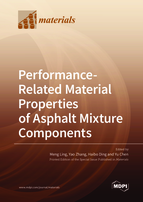Performance-Related Material Properties of Asphalt Mixture Components
A special issue of Materials (ISSN 1996-1944). This special issue belongs to the section "Construction and Building Materials".
Deadline for manuscript submissions: closed (10 January 2023) | Viewed by 24763
Special Issue Editors
Interests: asphalt pavements; oxidative aging; fracture mechanics; numerical modeling; artificial neural networks
Special Issues, Collections and Topics in MDPI journals
Interests: pavement structure and performance; multi-scale mechanical response of asphalt pavement; pavement recycling technology; advanced pavement materials
Special Issues, Collections and Topics in MDPI journals
Interests: pavement cracking; thermoreversible aging; wax in asphalt; performance characterization
Special Issues, Collections and Topics in MDPI journals
Interests: asphalt pavement; jointed concrete pavement; long-term pavement performance; mechanistic-empirical model; machine learning
Special Issues, Collections and Topics in MDPI journals
Special Issue Information
Dear Colleagues,
Each component of asphalt mixture (e.g., asphalt binder, aggregate, recycled materials and additives) directly affects the performance of asphalt mixture and asphalt pavement, such as fracture, permanent deformation, aging and moisture. Different damage modes are induced by different mechanisms and/or under different environmental conditions, and the contribution of each component to resist different types of damage is different. Therefore, it is vital to accurately evaluate the effects of the fundamental properties of asphalt mixture components and the component interactions that are related to damage performance, which are critical to develop performance models for asphalt mixture. The assessment of material properties becomes essential when recycled materials and/or additives are involved.
The Special Issue “Performance-Related Material Properties of Asphalt Mixture Components” aims to publish original research articles to determine the fundamental properties of asphalt mixture components that are related to the distress/performance of asphalt mixtures and asphalt pavements.
Topics include, but are not limited to:
- Influence of viscoelastic properties of asphalt mixture components on performance;
- Influence of morphological properties of asphalt mixture components on performance;
- Influence of chemical properties of asphalt binder on the durability of asphalt pavement;
- Evaluation of asphalt binder and aggregate interaction;
- Numerical modeling of asphalt mixture components and their interactions;
- Environmental effects on asphalt mixture components and performance;
- Performance of asphalt mixtures with recycled materials.
It is our pleasure to invite you to submit a manuscript to this Special Issue.
Dr. Meng Ling
Dr. Yao Zhang
Dr. Haibo Ding
Dr. Yu Chen
Guest Editors
Manuscript Submission Information
Manuscripts should be submitted online at www.mdpi.com by registering and logging in to this website. Once you are registered, click here to go to the submission form. Manuscripts can be submitted until the deadline. All submissions that pass pre-check are peer-reviewed. Accepted papers will be published continuously in the journal (as soon as accepted) and will be listed together on the special issue website. Research articles, review articles as well as short communications are invited. For planned papers, a title and short abstract (about 100 words) can be sent to the Editorial Office for announcement on this website.
Submitted manuscripts should not have been published previously, nor be under consideration for publication elsewhere (except conference proceedings papers). All manuscripts are thoroughly refereed through a single-blind peer-review process. A guide for authors and other relevant information for submission of manuscripts is available on the Instructions for Authors page. Materials is an international peer-reviewed open access semimonthly journal published by MDPI.
Please visit the Instructions for Authors page before submitting a manuscript. The Article Processing Charge (APC) for publication in this open access journal is 2600 CHF (Swiss Francs). Submitted papers should be well formatted and use good English. Authors may use MDPI's English editing service prior to publication or during author revisions.
Keywords
- asphalt binder
- aggregate
- recycled materials
- distress
- material properties
- numerical modelling










